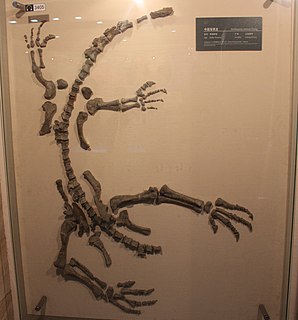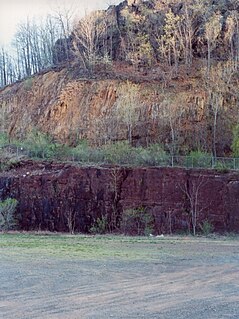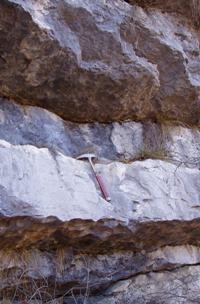
Anchisaurus is a genus of basal sauropodomorph dinosaur. It lived during the Early Jurassic Period, and its fossils have been found in the red sandstone of the Portland Formation, Northeastern United States, which was deposited from the Hettangian age into the Sinemurian age, between about 200 and 195 million years ago. Until recently it was classed as a member of Prosauropoda. The genus name Anchisaurus comes from the Greek αγχιanchi-; "near, close" + Greek σαυρος ; "lizard". Anchisaurus was coined as a replacement name for "Amphisaurus", which was itself a replacement name for Hitchcock's "Megadactylus", both of which had already been used for other animals.

Vulcanodon is an extinct genus of sauropod dinosaur from the Early Jurassic of southern Africa. The only known species is V. karibaensis. Discovered in 1969 in Zimbabwe, it was regarded as the earliest-known sauropod for decades, and is still one of the most primitive sauropods that has been discovered. As a quadrupedal, ground-dwelling herbivore, Vulcanodon already showed the typical sauropod body plan with column-like legs and a long neck and tail. It was smaller than most other sauropods, measuring approximately eleven metres (36 ft) in length. Vulcanodon is known from a fragmentary skeleton including much of the pelvic girdle, hindlimbs, forearms, and tail, but lacking the trunk and neck vertebrae as well as the skull.

Gyposaurus is a genus of basal sauropodomorph dinosaur from the early Jurassic of South Africa. It is usually considered to represent juveniles of other prosauropods, but "G." sinensis is regarded as a possibly valid species.
Chinshakiangosaurus is a genus of dinosaur and probably one of the most basal sauropods known. The only species, Chinshakiangosaurus chunghoensis, is known from a fragmentary skeleton found in Lower Jurassic rocks in China. Chinshakiangosaurus is one of the few basal sauropods with preserved skull bones and therefore important for the understanding of the early evolution of this group. It shows that early sauropods may have possessed fleshy cheeks.
Peter Malcolm Galton is a British vertebrate paleontologist who has to date written or co-written about 190 papers in scientific journals or chapters in paleontology textbooks, especially on ornithischian and prosauropod dinosaurs.
The Lufeng Formation is a Lower Jurassic sedimentary rock formation found in Yunnan, China. It has two units: the lower Dull Purplish Beds/Shawan Member are of Hettangian age, and Dark Red Beds/Zhangjia'ao Member are of Sinemurian age. It is known for its fossils of early dinosaurs. The Dull Purplish Beds have yielded the possible therizinosaur Eshanosaurus, the possible theropod Lukousaurus, and the "prosauropods" "Gyposaurus" sinensis, Lufengosaurus, Jingshanosaurus, and Yunnanosaurus. Dinosaurs discovered in the Dark Red Beds include the theropod Sinosaurus triassicus, the "prosauropods" "Gyposaurus", Lufengosaurus, and Yunnanosaurus, indeterminate remains of sauropods, and the early armored dinosaurs Bienosaurus and Tatisaurus.
The Bushveld Sandstone is a geological formation dating to roughly between 201 and 189 million years ago and covering the Carnian to Norian stages. The Bushveld Sandstone is found in Transvaal, South Africa and is a member of the Stormberg Group. As its name suggests, it consists mainly of sandstone. Fossils of the prosauropod dinosaur Massospondylus have been recovered from the Bushveld Sandstone.

Anchisauria is an extinct clade of sauropodomorph dinosaurs that lived from the Late Triassic to the Late Cretaceous. The name Anchisauria was first used by Galton and Upchurch in the second edition of The Dinosauria. It is a node-based taxon containing the most recent common ancestor of Anchisaurus polyzelus and Melanorosaurus readi, and all its descendants. Galton and Upchurch assigned a family of dinosaurs to the Anchisauria: the Melanorosauridae. The more common prosauropods Plateosaurus and Massospondylus were placed in the sister clade Plateosauria.
The Löwenstein Formation is a lithostratigraphic formation of the Keuper in Germany. It is underlain by the Mainhardt Formation and overlain by the Trossingen Formation. It dates back to the middle Norian.
The Nam Phong Formation, which correlates to the Indosinian III Unconformity, is a geological formation in Thailand. It underlies the Khorat Group. It consists of resistant, red-brown micaceous sandstones, conglomerates, siltstones and mudstones of mainly fluvial origin. The sandstones are medium to very fine-grained and are usually calcareous. The conglomerates contain pebbles of quartz, brown and grey chert, and reddish brown siltstone. Cross bedding and plane-bed stratification are common in the sandstones and conglomerates. The sandstones and conglomerates make up approximately 30% of the formation. This sedimentary rock formation is found in Khon Kaen Province, Thailand. It is of Norian to Rhaetian age to age, and is notable for its fossils of early dinosaurs.
The Portland Formation is a geological formation in Connecticut and Massachusetts in the northeastern United States. It dates back to the Early Jurassic period. The formation consists mainly of sandstone laid down by a series of lakes and the floodplain of a river. The sedimentary rock layers representing the entire Portland Formation are over 4 kilometres (2.5 mi) thick and were formed over about 4 million years of time, from the Hettangian age to the late Hettangian and Sinemurian ages.

The Shuttle Meadow Formation is a Mesozoic geologic formation in the Hartford Basin in Connecticut and Massachusetts, USA. Insect fossils of Mormolucoides articulatus and dinosaur remains are among the fossils that have been recovered from the formation; Coelophysis sp.

Main Dolomite is a lithostratigraphic unit in the Alps of Europe. Formation was defined by K.W. Gümbel in 1857.
The Dürrestein Formation is a Carnian geologic formation in Italy. Fossil prosauropod tracks have been reported from the formation.
The Montemarcello Formation is a Late Triassic (Carnian) geologic formation in Liguria, Italy. Fossil prosauropod tracks have been reported from the formation.
The Wangi Formation is a Mesozoic geologic formation in China. Indeterminate fossil dinosaur tracks have been reported from the formation.
The Jinjiang Formation is a Mesozoic geologic formation in China. Indeterminate fossil dinosaur tracks have been reported from the formation.
The Zhenzhuchong Formation is an Early Jurassic geologic formation in China. Plesiosaur remains are among the fossils that have been recovered from its strata. Remains of the prosauropod Lufengosaurus huenei have been recovered from this formation As well as dinosaur footprints.

Paleontology in Connecticut refers to paleontological research occurring within or conducted by people from the U.S. state of Connecticut. Apart from its famous dinosaur tracks, the fossil record in Connecticut is relatively sparse. The oldest known fossils in Connecticut date back to the Triassic period. At the time, Pangaea was beginning to divide and local rift valleys became massive lakes. A wide variety of vegetation, invertebrates and reptiles are known from Triassic Connecticut. During the Early Jurassic local dinosaurs left behind an abundance of footprints that would later fossilize.

The Nugget Sandstone is a Late Triassic to Early Jurassic geologic formation that outcrops in Colorado, Idaho and Utah, western United States. Fossil theropod tracks have been reported from the formation.







